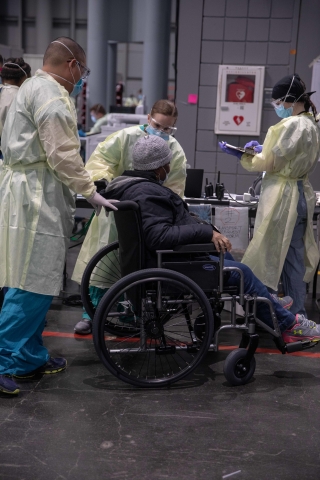
Staff and students from the Surface Warfare Engineering School Command Great Lakes in Illinois participated in a silent march for suicide prevention awareness October 14. Military and veteran suicides appear to be on the upswing during the COVID-19 pandemic. Navy photo by Brian Walsh
WASHINGTON — How much has the COVID-19 pandemic increased rates of suicide in the United States?
Last month, President Donald Trump signed an executive order directing DoD, VA and other federal agencies to explore that link.
COVID-19, which as of last month had killed 225,000 people in the United States, “has exacerbated mental and behavioral health conditions as a result of stress from prolonged lockdown orders, lost employment and social isolation,” Trump said in the order. Survey data from the CDC released just prior to the executive order showed that, during the last week of June, 40.9% of Americans struggled with mental health and substance abuse issues and 10.7% report seriously considering suicide.
The executive order directs government agencies to form a Coronavirus Mental Health Working Group. The group’s mandate is to “examine existing protocols and evidence-based programs that may serve as models to better support at-risk groups.” The order gives the group 45 days to submit a report to the president outline a plan for improved service coordination between stakeholders.
The executive order was released while Trump was a patient at Walter Reed National Military Medical Center in Bethesda, MD, receiving care for COVID-19.
It also came less than week after DoD released its Annual Suicide Report for 2019, which shows that suicide rates among active duty servicemembers increased for the fifth year in a row in 2019. The report notes that, after accounting for various risk factors, the suicide rates among the military are comparable to those in the general population, with young, enlisted servicemembers being the most at risk.
Karen Orvis, PhD, director of the Defense Suicide Prevention Office, said that it was too early to determine whether rates will increase in 2020.
“We will need to have a full year of data and investigations completed to determine cause of death,” she said.
Suicide Rate Jumps Up

In New York in April 2020, staff from the 11th Field Hospital, deployed from Fort Hood, TX, discharged a recovered COVID-19 patient at the Javits New York Medical Station. The stress of the pandemic appears to have increased suicide rates across the nation. Army photo by Cpl. Rachel Thicklin
Around the time of the report’s release, however, Army officials began reporting anonymously to major news outlets that the suicide rate had jumped as much as 30% during the pandemic. While DoD had yet to make the third quarter suicide figures public, the numbers for the first half of 2020 bear that out. According to DoD’s suicide reports for the first half of 2020, the Army had reported 81 suicides among enlisted servicemembers compared to 67 over that time frame last year.
Meanwhile, VA researchers are working to discover whether broad screening for suicide risk is effective in VA emergency departments. The study being conducted at the Rocky Mountain Regional VAMC stems from a report in 2016 noting that a significant number of individuals who died by suicide were not receiving mental healthcare. Instead, in the months prior to their deaths, they were seen in primary care, emergency department (ED) or other medical settings. The report highlighted the need for suicide risk screening across all medical settings.
“During the last decade, the VA has made significant strides in suicide prevention,” said the study’s authors, whose early results were published on JAMA’s Open Network last month. “However, most of these efforts have focused on downstream interventions to reduce suicidal behavior among those already identified to be at high risk.”
Recognizing that the department needed more upstream efforts at screening for suicide risk, VA created a workgroup that eventually resulted in the VA Suicide Risk Identification Strategy (RISK ID)—a three-stage suicide risk screening and evaluation process that can be used in ambulatory care settings, EDs and urgent care centers (UCCs).
The Colorado VA study looked at four million veterans screened in these settings in 2019. It found that approximately 3.5% screened positive for suicidal ideation during visits that were mostly for nonmental healthcare concerns. The risk was greater among patients presenting in EDs and UCCs than in ambulatory care.
The results confirm that screening in settings where the patient has only a short exposure to VA healthcare can be effective in identifying at-risk veterans. And while there were fewer screened positives in ambulatory care, the study’s authors noted that it was a significant enough number that improving screening in ambulatory care settings would still be beneficial.
“First year findings indicate that population-based screening and evaluation in VA ambulatory care, ED or UCC settings is not only feasible but may also help identify risk among patients who for the most part may not be receiving or seeking mental health care,” the study’s authors stated.
The authors also noted that veterans who commit suicide are more likely to do so using a firearm. “Brief interventions focused on lethal means safety are also warranted given increased rates by firearm in this population,” they said.

